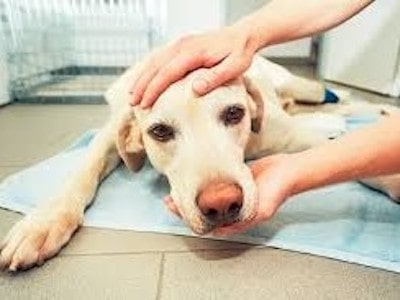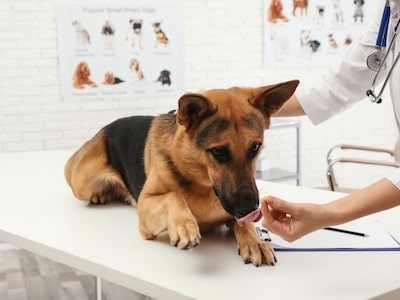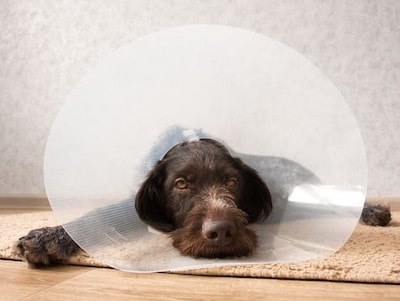After a successful surgery, it’s only natural for pet owners to feel relieved and hopeful about their dog’s recovery. However, one common concern that might catch you off guard is seeing your furry companion shaking or trembling after the procedure.
If you’ve ever asked yourself, “Why is my dog shaking after surgery?” you’re not alone.
In this article, we’ll delve into the various factors that could lead to post-surgery shivering in dogs, helping you understand what’s behind this behavior and how you can provide the best care and support during their healing process.
So, let’s uncover the mystery behind your canine companion’s post-operative shivers and find out how to ensure their comfort and well-being.
Contents
Is Shaking After Surgery Normal?
Surgery is a stressful and painful experience for any living being, including our canine companions. Dogs need anesthesia when they undergo surgery or any other type of painful procedure where we don’t want them to feel that.
It could be due to a wound repair if they need stitches, and it could even be dental procedures where we have to do x-rays and require them to have their mouth open for extended periods.

Anesthesia is a medical treatment that controls unconsciousness, preventing your dog from moving or feeling pain during a procedure. The drug works by interrupting the pathways in the neurological system to block incoming pain signals from getting to the brain.
Anesthesia has many uses in dogs[1]. Local anesthesia may be an option if your veterinarian needs to remove a small growth on your dog’s skin, perform a biopsy of a growth or an area of skin, use stitches to close a small cut or wound, or perform any type of minimally painful procedure during which unconsciousness is not required.
However, anesthesia also has some side effects that can affect your dog’s recovery. One of the most common side effects is shaking or shivering, which can occur during or after the procedure.
Dr. Jerry Klein, chief veterinary officer at AKC says, “Through years of study, practice, and advancement in veterinary education, the anaesthetic given to dogs has improved.”
Shaking is usually a normal and temporary response to anesthesia, but it can also indicate a serious problem that requires immediate attention. Therefore, it is important to understand why your dog may shake after surgery and how to help them feel better.
Possible Causes of Post-Surgery Shaking
There are several possible causes of post-surgery shaking in dogs, such as:
- Pain: Pain is one of the most common reasons why dogs shake after surgery. Even though anesthesia blocks the pain during the procedure, it wears off gradually and your dog may start feeling discomfort or soreness in the affected area. Pain can also cause anxiety and stress, which can trigger shaking as well.
- Stress: Stress is another common factor that can cause shaking after surgery.
Your dog may be stressed by the unfamiliar environment, the presence of strangers, the separation from you, or the memory of the procedure.
Stress can also affect your dog’s body temperature, blood pressure, heart rate, and breathing, which can lead to shaking.

- Low blood sugar: Low blood sugar, or hypoglycemia, can occur in dogs after surgery due to fasting, vomiting, diarrhea, or reduced appetite.
Low blood sugar can cause weakness, confusion, tremors, seizures, or coma in severe cases. Your dog may need glucose supplementation to restore their blood sugar levels.
- Hypothermia: Low body temperature, or hypothermia, can occur in dogs after surgery due to exposure to cold surfaces, fluids, or air; loss of body heat; or reduced metabolism.
“Pets that experience hyperthermia are at greater risk for subsequent heat stroke due to damage to the thermoregulatory center”, says Krista Williams, DVM, from VCA Hospitals.
Low body temperature can cause shivering, lethargy, slow breathing, slow heart rate, or cardiac arrest in extreme cases. Your dog may need warming blankets, heating pads, or warm fluids to raise their body temperature.
- Medication side effects: Some medications that are used during or after surgery can cause shaking as a side effect.
For example, opioids such as morphine or fentanyl can cause muscle twitching or tremors; anticholinergics such as atropine or glycopyrrolate can cause dry mouth or increased heart rate; and alpha-2 agonists such as dexmedetomidine or xylazine can cause sedation or bradycardia.
Signs of Post-Surgery Complications
Some signs and symptoms of post-surgery complications that may require immediate veterinary attention include:
- Excessive bleeding: Excessive bleeding from the surgical site or from other areas such as the nose, mouth, eyes, ears, or anus can indicate a problem with clotting, infection, trauma, or internal bleeding. Your dog may need sutures, bandages, antibiotics, transfusions, or surgery to stop the bleeding.
- Infection: Infection can occur at the surgical site or in other parts of the body due to bacteria, viruses, fungi, or parasites. Infection can cause redness, swelling, heat, pain, pus, odor, fever, or lethargy. Your dog may need antibiotics, antifungals, antiparasitics, or surgery to treat the infection.

- Vomiting or diarrhea: Vomiting or diarrhea can occur in dogs after surgery due to anesthesia, stress, pain, medication, or dietary changes.
Vomiting or diarrhea can cause dehydration, electrolyte imbalance, acid-base imbalance, or intestinal obstruction.
Your dog may need fluids, electrolytes, antiemetics, antidiarrheals, or surgery to treat the vomiting or diarrhea.
- Difficulty breathing: Difficulty breathing can occur in dogs after surgery due to anesthesia, pain, stress, medication, fluid accumulation, airway obstruction, or lung damage.
Difficulty breathing can cause cyanosis, coughing, wheezing, gasping, or collapse. Your dog may need oxygen, bronchodilators, diuretics, steroids, or surgery to treat the difficulty breathing.
If you notice any of these signs or symptoms in your dog after surgery, contact your veterinarian immediately or take your dog to an emergency clinic. Do not wait for the shaking to stop or assume that it is normal. Your dog may be in a life-threatening situation and need urgent medical care.
When to Worry About Dog Shaking After Surgery?
While dog shaking after surgery is usually normal and harmless, there are some situations where you should be concerned and seek veterinary attention. These include:
- Your dog’s shaking is severe or persistent: If your dog is shaking violently or non-stop after surgery, this could indicate a serious problem such as hypothermia, infection, internal bleeding, or organ failure.
You should check your dog’s temperature, pulse, breathing, and gum color, and contact your vet immediately if you notice any abnormalities.

- Your dog’s shaking is accompanied by other symptoms: If your dog is shaking after surgery and also showing signs of distress, pain, or illness, such as vomiting, diarrhea, lethargy, loss of appetite, difficulty breathing, or seizures, this could indicate a complication or an adverse reaction to the anesthesia or medication. You should contact your vet as soon as possible and follow their instructions.
- Your dog’s shaking does not improve after a few days: If your dog is still shaking after surgery even after a few days of rest and recovery, this could indicate a chronic or underlying condition that needs further investigation.
Some of the possible causes of chronic shaking in dogs include neurological disorders, hormonal imbalances, kidney disease, liver disease, or cancer. You should consult your vet for a proper diagnosis and treatment plan.
Solutions for Post-Surgery Shaking
There are some practical and effective ways to help your dog cope with post-surgery shaking, such as:
- Providing warmth: Providing warmth can help your dog maintain their body temperature and prevent hypothermia. You can use warming blankets, heating pads, warm water bottles, or warm towels to wrap your dog gently and keep them cozy. Make sure to check your dog’s temperature regularly and avoid overheating them.
- Providing comfort: Providing comfort can help your dog reduce their stress and anxiety and feel more secure. You can use soft bedding, toys, treats, music, aromatherapy, or massage to calm your dog and distract them from the pain. You can also stay with your dog and talk to them softly and reassuringly.

- Providing hydration: Providing hydration can help your dog replenish their fluids and prevent dehydration. You can offer your dog fresh water or low-sodium broth in small amounts and frequently.
You can also moisten their food or give them ice chips to stimulate their appetite. If your dog is vomiting or has diarrhea, you may need to give them fluids intravenously or subcutaneously.
- Providing nutrition: Providing nutrition can help your dog restore their blood sugar and energy levels and prevent hypoglycemia[2]. You can offer your dog bland food such as boiled chicken and rice or canned food in small amounts and frequently.
You can also add honey or corn syrup to their food or water to boost their glucose levels. If your dog is not eating or has diabetes, you may need to give them glucose intravenously or subcutaneously.
- Providing pain relief: Providing pain relief can help your dog alleviate their discomfort and inflammation and prevent excessive shaking.
You can give your dog pain medications such as nonsteroidal anti-inflammatory drugs (NSAIDs) or opioids as prescribed by your veterinarian. Do not give your dog human painkillers such as aspirin or ibuprofen as they can be toxic for dogs.
You can also prevent or reduce post-surgery shaking in the future by preparing your dog for surgery, choosing a reputable veterinarian and anesthetic protocol, and following post-operative care guidelines.
FAQs
How long will my dog continue to shake after surgery?
The duration of post-surgery shaking can vary depending on the individual dog and the specific factors affecting them. In general, the shivering should decrease within the first 24-48 hours after the surgery. If it persists beyond this timeframe or worsens, seeking veterinary advice is recommended.
Should I be concerned if my dog experiences mild shaking after surgery?
Mild shaking or trembling immediately after surgery is often a normal response to the stress and anesthesia. However, it’s essential to monitor your dog closely. If the shaking persists, worsens, or is accompanied by other concerning symptoms such as excessive panting, vomiting, or refusal to eat, it’s best to consult your veterinarian promptly.
Are there any home remedies to alleviate post-surgery shaking in dogs?
While some mild shaking may resolve on its own, it’s essential to follow your veterinarian’s post-operative care instructions. Home remedies should not replace professional veterinary advice. Providing a stress-free environment, proper pain management, and ensuring your dog’s comfort are key to supporting their recovery.
Can post-surgery shaking be prevented in dogs?
While it’s challenging to prevent all instances of post-surgery shaking, there are steps you can take to minimize its occurrence. These include providing pre-surgery instructions, discussing pain management options with your veterinarian, and ensuring your dog receives proper care and monitoring during the recovery period.
Conclusion
Shaking after surgery is a common phenomenon in dogs that can have various causes such as pain, stress, low blood sugar, low body temperature, or medication side effects.
Shaking is usually normal and temporary, but it can also indicate a serious complication that requires immediate veterinary attention.
Therefore, it is important to monitor your dog’s recovery and vital signs and contact your veterinarian if you have any concerns.
You can help your dog cope with post-surgery shaking by providing warmth, comfort, hydration, nutrition, and pain relief.
You can also prevent or reduce post-surgery shaking in the future by preparing your dog for surgery, choosing a reputable veterinarian and anesthetic protocol, and following post-operative care guidelines.
Reference:
- Portier, K., & Ida, K. K. (2020). Editorial: Anesthetic Risk and Complications in Veterinary Medicine. Frontiers
- Doyle, M., & Olsen, N. S. (1957). Hypoglycemia in dogs and recovery after intracisternal administration of glucose. American Journal of Physiology, 191(2), 367–370. American Physiological Society

A retired veterinary technician and full-time dog parent. James knows to serve the community with the best of his knowledge of animal healthcare. He has been working in a known veterinary clinic for quite a few years. He loves reading blogs on pet nutrition and writes unbiased reviews of dog products.


